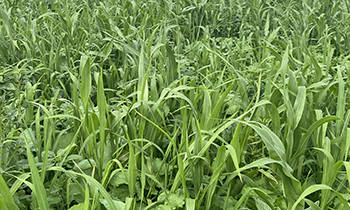With freeze in the forecast, remember the risk of prussic acid poisoning

Sorghum sudan grass and peas in early August.
10/27/23
AMES, Iowa – Temperatures will be dropping to below freezing this weekend which can increase the risk of prussic acid poisoning for cattle grazing sorghum-type forages. Freeze-damaged plant cells build up prussic acid which is a cyanide compound that can kill cattle within minutes if they graze high risk forages. Grain sorghum has the highest risk while sorghum-sudangrass hybrids are intermediate risk. Straight sudan grass is low to intermediate risk and pearl millet is very low risk.
Young rapidly growing plants will have the highest levels which may be an issue for cover crops or regrowth after harvesting. Sudan grass should be at least 18 inches tall before grazing and sorghum-sudan grass should be 24 inches. Fields that have been fertilized also can have higher levels of prussic acid.
After a killing frost, remember to wait at least five to six days before grazing to allow the prussic acid to dissipate before putting your cattle at risk. Don’t let hungry cattle graze on high risk fields or they can consume enough to be deadly. See more information on the potential for prussic acid poisoning.
-30-
The Iowa Beef Center at Iowa State University was established in 1996 with the goal of supporting the growth and vitality of the state’s beef cattle industry. It comprises faculty and staff from Iowa State University Extension and Outreach, College of Agriculture and Life Sciences and College of Veterinary Medicine, and works to develop and deliver the latest research-based information regarding the beef cattle industry. For more information about IBC, visit www.iowabeefcenter.org.
Contact:
Grant Dewell, ISU Extension beef veterinarian 515-294-2822, gdewell@iastate.edu
